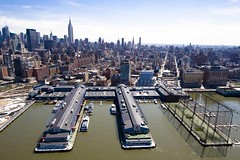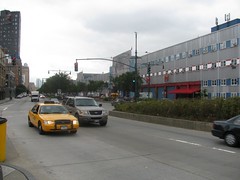Chelsea Piers

A waterfront complex designed by Warren & Wetmore and opened in 1910, these piers were a major hub for both freight and passenger liners; many immigrants actually docked here first before being taken by ferry to Ellis Island. Troops departed from here to the European front in both world wars.

As passengers took to the air and freight traffic shifted to New Jersey, the Chelsea Piers declined, until by the 1980s they were almost demolished for the West Side Highway project. When that fell through, the piers were turned over to a private entity, Chelsea Piers Management, for development into a sports complex—which opened in stages starting in 1995.
Pier 60
Jesse Owens sailed from this pier in 1936 aboard the S.S. Manhattan to take part in the Berlin Olympics. Now houses the Sports Center at Chelsea Piers, featuring swimming, running, cycling, rock climbing, basketball, sand volleyball, boxing, weight lifting, yoga, pilates and more. Also the Pier 60 event space.